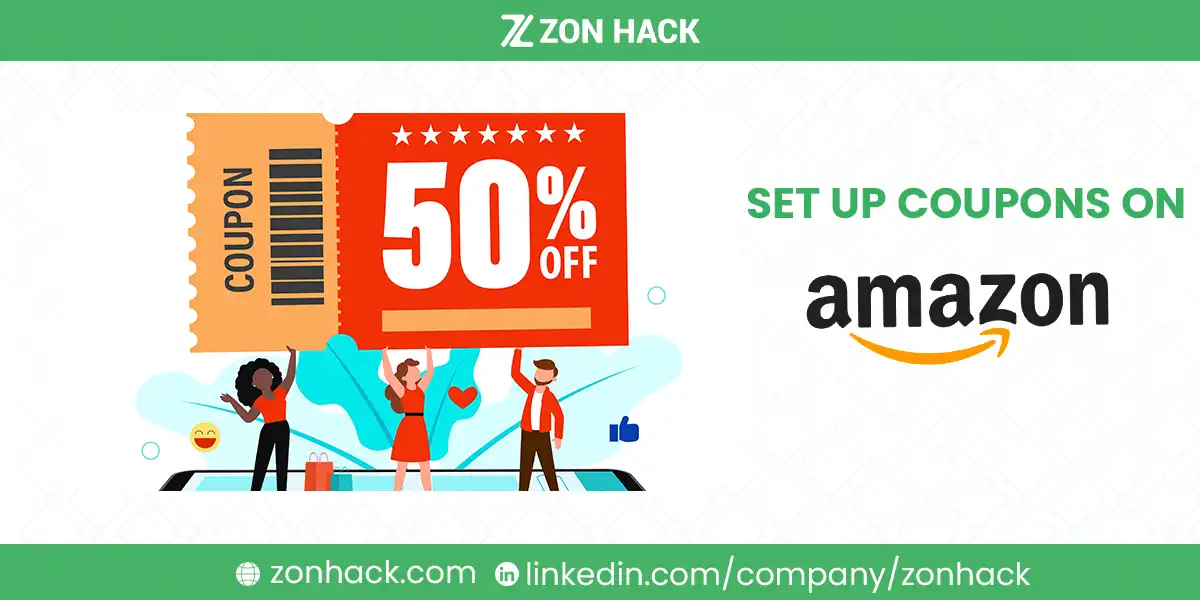If you’re selling on Amazon and looking for a powerful yet underutilized promotional tool, coupons might be your secret weapon. Whether you’re launching a new product, trying to boost visibility, or simply looking to offload slow-moving inventory, coupons can give your listings the competitive edge they need.
This guide, created by ZonHack, walks you through the entire process of setting up Amazon coupons—from understanding how they work to managing them effectively post-launch. Let’s break it down.
What Are Coupons on Amazon?
Coupons on Amazon are digital discounts that shoppers can either clip or automatically apply during checkout. They function similarly to traditional store coupons but are tailored for Amazon’s digital environment.
When a customer sees a green “Save $5 with coupon” tag on a product listing, that’s a seller-driven coupon. These incentives show up on search results, product pages, the Amazon Coupons page, and even in emails sent by Amazon to deal-hunting customers.
You can offer two types of discounts:
- Percentage off (e.g., 10% off)
- Money off (e.g., $5 off)
Once a coupon is clipped, the discount applies automatically when the customer checks out.
Why Use Coupons?
Coupons are one of the few tools that help increase both traffic and conversion rates simultaneously. Here’s how:
- Drive traffic: Coupons increase your chances of showing up on Amazon’s “Today’s Deals” or “Coupons” page.
- Improve visibility: Products with coupons often feature a bright green tag in search results.
- Boost conversion: Shoppers love a good deal. Even a small discount can push them to hit that Buy Now button.
- Liquidate excess stock: Great for products with low sales velocity or during inventory clean-up.
- Reach new customers: Target niche audiences like Prime members or Amazon Mom members.
According to Amazon, sellers who use coupons can see up to a 7-10% increase in conversion rates when compared to non-couponed listings.
Coupons vs. Promotions: What’s the Difference?
Amazon offers several types of promotions:
- Coupons: Visible, clip-able discounts for buyers. Includes a $0.60 redemption fee per use.
- Deals: Typically Lightning Deals or 7-day deals, usually on the “Deals” page.
- Promotions: Can be BOGO, tiered discounts, or social media codes.
- Discounts: Built-in price drops not tied to any campaign.
Coupons are especially powerful because they are visually tagged, increasing discoverability. While promotions may offer more customization, coupons win on visibility and user engagement.
Eligibility Requirements for Amazon Coupons
Before you start setting up coupons, make sure your account and products are eligible.
Seller Requirements
- You must have a Professional Selling Plan.
- Your account must maintain an average rating of 3.5 stars or higher.
- If you have no feedback yet, you are still eligible.
Product Requirements
- Products must meet Amazon’s minimum customer review criteria.
- Some restricted categories (e.g., alcohol, adult items) are ineligible.
- Products should have sufficient inventory. Low inventory may lead Amazon to deactivate your coupon mid-campaign.
Amazon continuously monitors eligibility. If your listing falls below requirements (e.g., stock runs low), the coupon could be automatically paused or removed.
How to Set Up Coupons on Amazon (Step-by-Step)
Setting up coupons is straightforward, but each step has nuances that can affect your results.
Step 1: Access the Coupons Dashboard
Start by logging into Amazon Seller Central. Hover over “Advertising” in the top navigation and select “Coupons”.
If it’s your first time, Amazon will show you a setup intro page. Click “Create your first coupon” or, if you’ve used this tool before, select “Create a new coupon”.
Step 2: Add Products to Your Coupon
Use SKU or ASIN search to find the product(s) you want to include. You can add up to 200 ASINs per coupon.
After you add products, click “Continue” to proceed.
Step 3: Set Your Discount and Schedule
Choose between Money Off or Percentage Off.
Pro tip: For products over $10, go with “Money Off” so the savings look more tangible. For inexpensive items under $5, “Percentage Off” often feels more appealing.
Enter your discount value. You can offer anywhere from 5% to 80% off in most Amazon marketplaces.
Next, set the start and end dates. As of September 5, 2024, Amazon updated coupon durations:
| Coupon Type | Max Duration |
| Standard Coupon | 30 days |
| Reorder Coupon | 180 days |
| Subscribe & Save | 365 days |
Coupons become visible within 6 hours of submission.
You can also choose to limit one redemption per customer to avoid abuse.
Step 4: Set a Budget
You must set a campaign budget. This includes both:
- The discount value (what the customer saves)
- A $0.60 fee per redemption (charged by Amazon)
Let’s break down a simple example:
- You offer $5 off a $20 product.
- Your cost per redemption = $5 (discount) + $0.60 (fee) = $5.60
- If you set a $560 budget, you could fund roughly 100 redemptions.
Minimum budget is $100. Maximum is $10 million.
Amazon will pause your coupon if it hits 95% or 80% of your budget, depending on the settings, to prevent overspending. However, slight overages can still happen.
Step 5: Add Title and Target Audience
Enter a Coupon Title (max 100 characters). This won’t appear to customers, but it’s important for your internal organization.
Then, select your audience:
- All shoppers
- Amazon Prime
- Amazon Mom
- Amazon Student
You can run more targeted campaigns by selecting specific customer types.
Step 6: Review and Submit
Check all your settings carefully. Preview how the coupon will appear.
Once you’re ready, click “Submit Coupon”. You’ll receive a confirmation and the coupon will go live within hours.
How Customers See and Use Coupons
One of the best features of Amazon coupons is their high visibility. Customers don’t need to jump through hoops. They simply click “Clip Coupon” and the discount is automatically applied.
Here’s where coupons typically appear:
- Search results: Next to product title, with a green coupon label.
- Product detail page: Just below the price.
- Amazon Coupons page: Curated deals by category.
- Checkout page: Coupon is automatically deducted.
- Cart: Discount shows when the item is added.
Coupons work seamlessly on desktop, mobile, and the Amazon app.
According to internal seller data, listings with visible coupons can experience up to 3x higher click-through rates compared to those without.
Managing and Tracking Coupons on Amazon
Once your coupon is live, the job doesn’t end there. Successful Amazon sellers actively manage and optimize their coupons. Poorly managed coupons can drain your budget or lead to confusing promotions.
Where to Monitor Coupon Performance
Head to Seller Central > Advertising > Coupons Dashboard. This is where all your live, pending, and expired coupons live. From this dashboard, you can:
- View all active coupons
- Track total redemptions and clip rates
- Monitor budget usage
- See sales generated from each coupon campaign
The dashboard gives a snapshot of key data like:
- Start and end dates of each coupon
- Total budget and how much of it has been spent
- Number of redemptions (how many times the coupon has been used)
- Clip-through rate (how many people clipped the coupon vs. saw it)
If you’re running multiple promotions, this view is essential. It tells you what’s working and what’s wasting money.
Advanced Tracking with the All Orders Report
To dig deeper into how individual orders were affected by a coupon, you’ll need the All Orders report:
- Go to Reports > Fulfillment in Seller Central.
- Click on All Orders.
- Set your date range to match the coupon’s active period.
- Click Request Download.
- Once it’s ready, download the file.
This report includes:
- Order IDs
- Promo codes used
- ASINs and SKUs
- Shipping and billing info
Why it matters: You’ll see exactly which orders used which coupons, and which products benefited. This helps refine future promotions.
How Customers See and Use Your Coupons
Many new sellers wonder: How do customers even find these coupons?
Amazon automatically showcases active coupons in multiple high-traffic locations, including:
- Search results pages (highlighted under product listings)
- Product detail pages (under the price or Buy Now button)
- Checkout pages
- Amazon’s Coupons homepage (amazon.com/coupons)
- Mobile app deal sections
Once a customer clicks “Clip Coupon,” the discount is applied automatically at checkout. No manual codes, no confusion.
For ZonHack clients, this means more frictionless sales. The key is making sure the coupon is appealing enough to get clipped in the first place.
Best Practices and Tips for Running Profitable Coupons
If you want your coupon campaigns to be more than just a short-term boost, you need a strategy. Here’s what seasoned Amazon pros do:
1. Don’t Offer Discounts That Hurt Your Margins
It sounds obvious, but too many sellers offer deep discounts without checking their profit per unit. Remember, each redemption also costs you $0.60 in Amazon fees. That adds up.
Example: If you offer $5 off a $25 product, that’s a 20% discount + $0.60 fee = $5.60 cost per redemption.
Make sure your profit margins can support it.
2. Combine Coupons with PPC Campaigns
This is where ZonHack can make a difference. Running Sponsored Product Ads on top of coupon listings amplifies visibility. Coupons attract clicks. PPC brings traffic. Together, they boost conversion.
Amazon even prioritizes sponsored products with active coupons in search rankings.
3. Use Coupons to Launch New Products
New ASINs often struggle with visibility. A well-timed coupon can:
- Encourage early adoption
- Generate initial reviews
- Push your product onto Amazon’s Coupons page
Launch coupons are a common ZonHack strategy for getting momentum quickly.
4. Schedule Coupons Around Shopping Events
Don’t just set and forget. Align your coupons with key Amazon events:
- Prime Day
- Black Friday / Cyber Monday
- Back to School Season
- Mother’s Day / Father’s Day
Plan 4–6 weeks in advance. Budget generously. Expect traffic spikes.
ZonHack Pro Tip: Use Coupons to Rank Your Products
One of the lesser-known uses of Amazon coupons? Keyword ranking.
Here’s how it works:
- Identify a high-traffic keyword.
- Optimize your listing for that keyword.
- Run a PPC campaign targeting the keyword.
- Layer a coupon on top.
The result? Higher CTR (click-through rate), better conversion, and improved organic rankings.
Amazon’s algorithm rewards listings that convert. Coupons grease the wheels.
Are Coupons Worth It?
Absolutely — if you use them smartly.
Coupons aren’t just about slashing prices. They’re tools for:
- Boosting visibility
- Increasing conversion rates
- Moving old inventory
- Building your brand
With ZonHack’s Amazon growth experts, coupons become part of a larger growth strategy. We help you:
- Time coupon campaigns with ad pushes
- Target the right audience
- Track ROI and adjust in real-time
For high-performing Amazon sellers, coupons are just the beginning. Smart sellers use them as launch pads for long-term success.
Ready to Grow with ZonHack?
At ZonHack, we help Amazon sellers like you build smart, scalable campaigns that turn simple tools, like coupons, into engines of growth.
Whether you’re launching a new ASIN, liquidating stock, or planning your next big holiday push, our team is ready to assist.
Book a free strategy session with ZonHack, and let us turn clicks into conversions.




